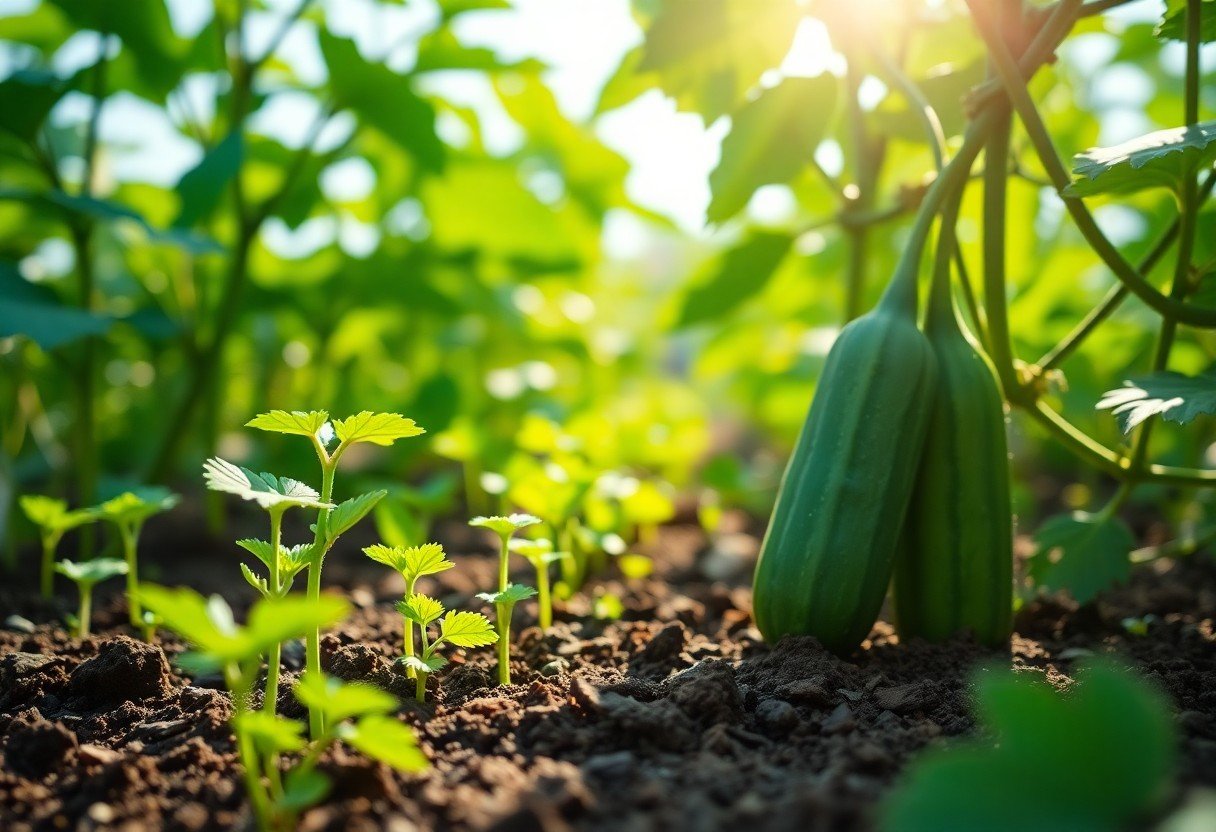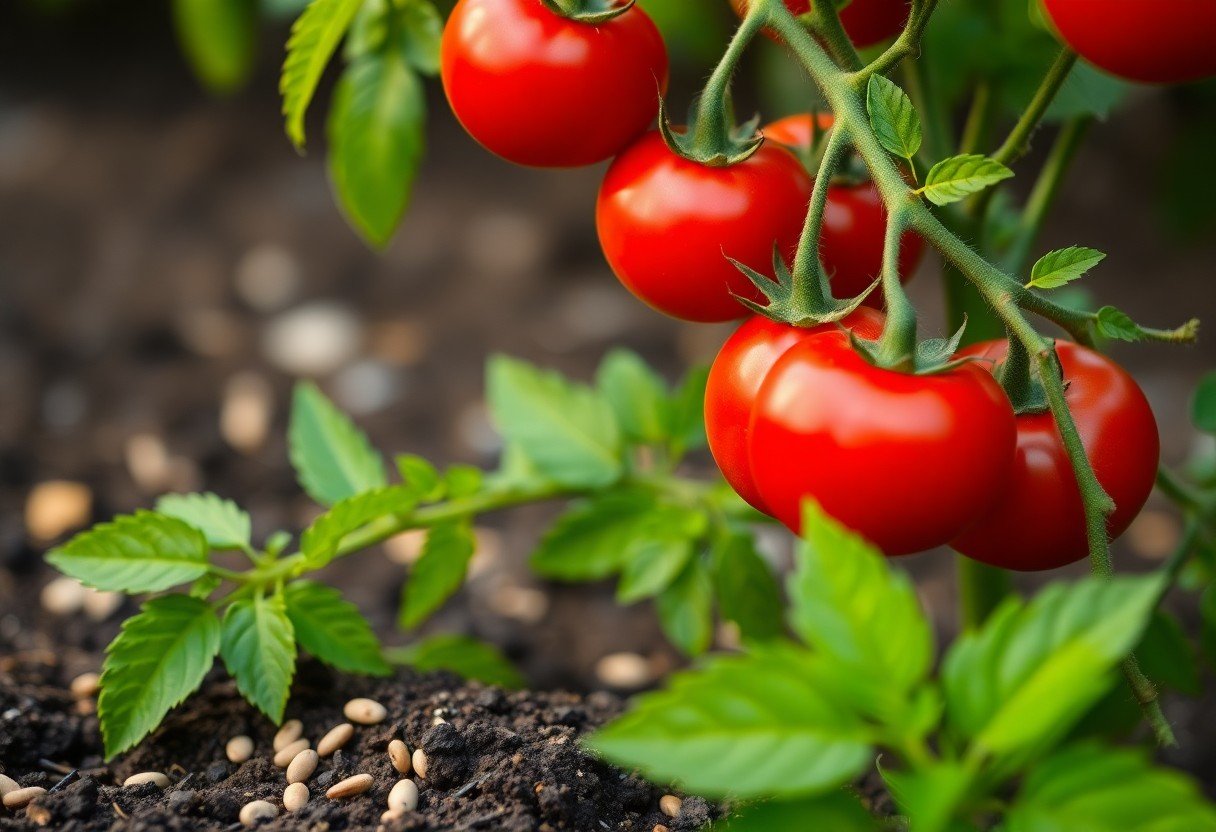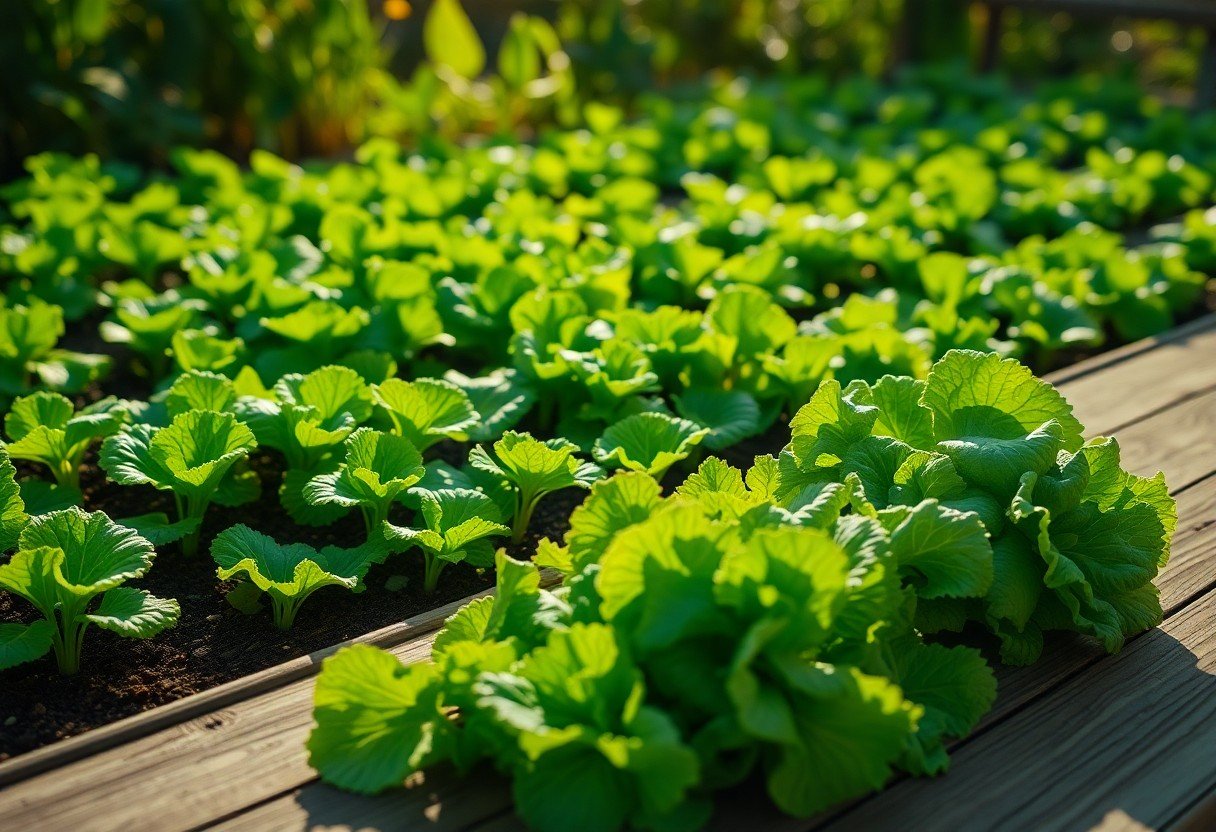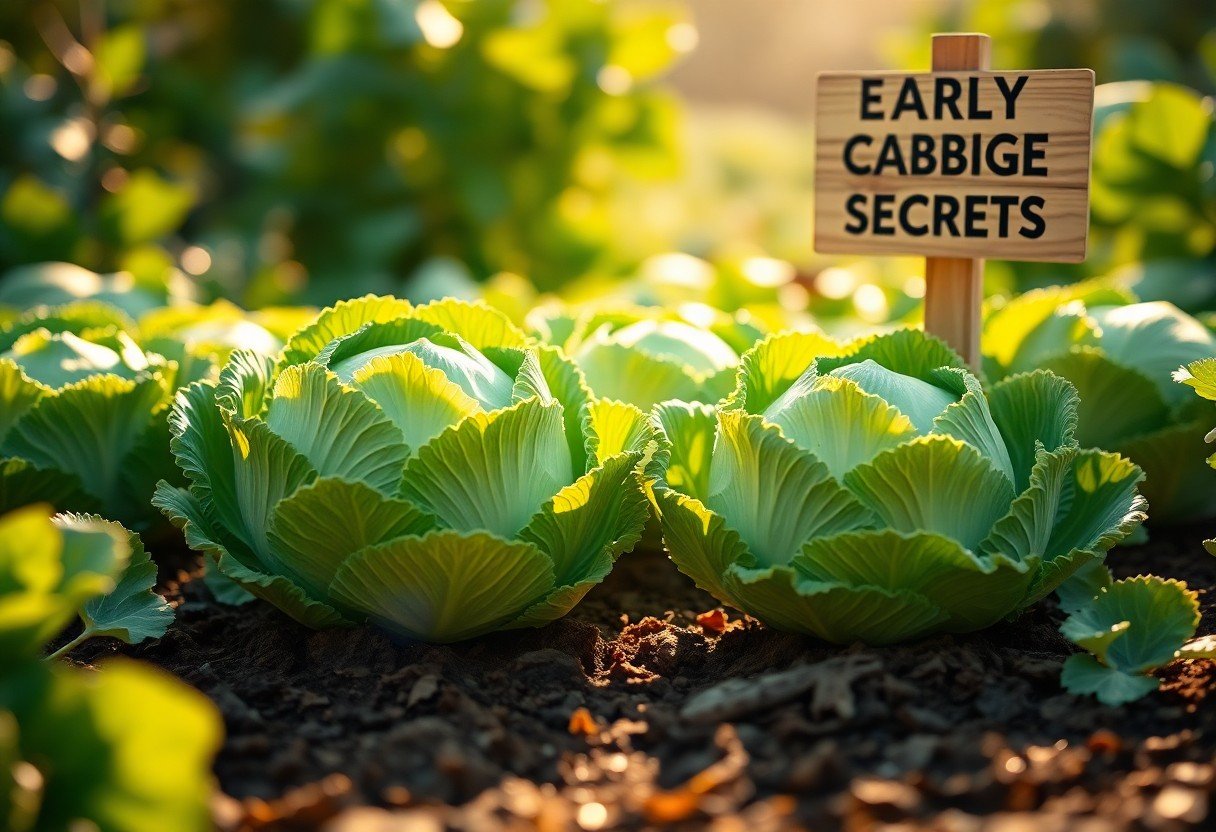Refreshing garden delights await you as you commence on a journey to grow your very own cucumbers. This comprehensive guide provides you with simple, step-by-step instructions to take you from planting the seeds to enjoying that crisp, cool crunch straight from your garden. Whether you’re a seasoned gardener or just starting out, you’ll find helpful tips and techniques tailored to ensure that your cucumber-growing experience is both enjoyable and rewarding. Dive in and discover how easy it is to cultivate this delicious vegetable right at home!
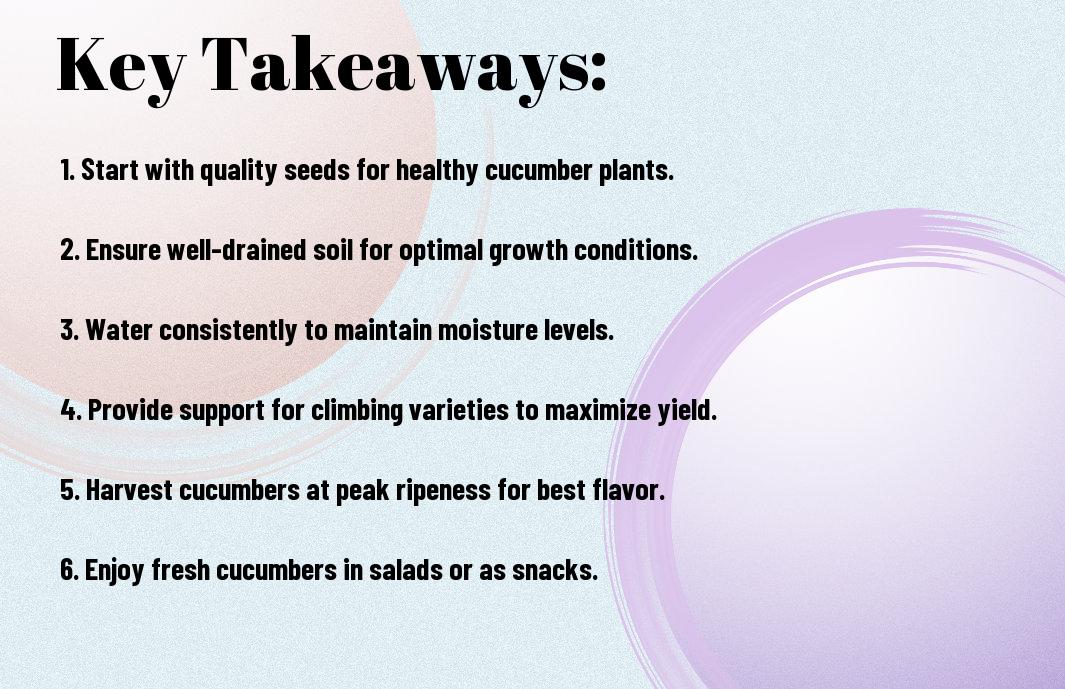
Understanding Cucumber Varieties
Before you investigate into the world of cucumbers, it’s important to familiarize yourself with the various types that exist. Each cucumber variety offers unique flavors, textures, and growth conditions, making them suitable for different gardening spaces and culinary uses. Whether you envision a crisp salad topping or a refreshing snack, understanding these distinctions will ensure you choose the perfect variety for your garden.
Popular Varieties for Home Gardens
The most popular cucumber varieties for home gardens include slicing cucumbers, pickling cucumbers, and specialty types like Persian or European cucumbers. Slicing cucumbers, known for their smooth skins and juicy flesh, are perfect for salads. On the other hand, pickling cucumbers tend to be shorter and bumpier, providing the ideal crunch for your pickling projects. Understanding these differences can help you decide which varieties best suit your culinary needs.
Choosing the Right Seeds
Against choosing cucumber seeds randomly, you should research specifics about the varieties you are interested in. Consider factors like your climate, available space, and goals for your garden. Some cucumbers thrive in cooler climates, while others flourish in the heat. Additionally, decide whether you’d like to grow them in containers or directly in the ground, as this can affect your choice of variety.
In addition to climate and growing conditions, think about the harvest time and plant size when selecting your seeds. Some cucumbers are fast-growing and produce fruit in just a few weeks, while others require a longer growing season. By aligning your seed choice with your garden’s specific needs, you’ll set yourself up for a bountiful and satisfying cucumber harvest.
Cucumber Chronicles – Preparing for Planting
Some of the most satisfying moments in gardening come from the anticipation of planting your seeds. Before you examine the excitement of sowing, it’s important to prepare your garden space adequately. This not only sets the tone for healthy growth but also maximizes your yields. Taking the time to choose the right soil and getting your planting conditions just right will pay off dearly when you bite into that crispy cucumber later on. This chapter breaks down how to lay a strong foundation for your plants.
Soil Selection and Preparation
Preparing your soil is the first step in ensuring a successful cucumber harvest. You want to opt for well-draining soil that is rich in organic matter. A mix of loamy soil and compost is often ideal, as it provides the nutrients your cucumbers need while retaining moisture. Before planting, you should also test the pH level of your soil, aiming for a range between 6.0 and 7.0. If your soil is too acidic or alkaline, you can amend it using lime or sulfur, respectively. Tilling the soil thoroughly allows you to break up compacted areas and aerate it, enabling roots to spread easily.
Ideal Planting Conditions
An crucial aspect of growing cucumbers is providing them with the right environmental conditions. You should aim to plant your seeds when the soil temperature reaches at least 70°F (21°C) and is consistently warm. Cucumbers thrive in full sun, so selecting a location that receives at least 6 hours of sunlight daily will promote healthy growth. If you’re planting outdoors, wait until all danger of frost has passed to avoid any setbacks in your cucumber production.
Planting your seeds during the correct time of year, usually late spring, can profoundly impact your success. Moreover, ensuring a nutrient-rich and well-draining soil will allow your young plants to establish a robust root system. Moreover, if you’re starting indoors, consider using seedling trays that can be transferred outdoors after your seedlings have developed a few true leaves—you’ll be setting your cucumbers up for a flourishing growth journey.

Planting Your Cucumbers
Not all gardens are created equal, and understanding where and how to plant your cucumber seeds can make all the difference in your harvest. You have the option of sowing seeds indoors or outdoors, and each method comes with its own set of advantages. By starting your seeds indoors, you can jump-start the growing season, particularly in cooler climates. This method gives you a head start, allowing you to transplant seedlings when the danger of frost has passed, thereby increasing your chances of a successful crop. Alternatively, sowing directly outdoors simplifies the process, encouraging cucumbers to adapt to their natural environment from the start. Consider your specific climate and preferability when deciding which route to take. Both methods can yield delicious cucumbers, but the initial conditions you set play a significant role in their growth trajectory.
Sowing Seeds Indoors vs. Outdoors
Besides the seasonality and climate, another consideration in your cucumber planting strategy is the specific conditions of your home or garden. If you choose to sow seeds indoors, ensure you have adequate light, moisture, and warmth to encourage germination. A sunny windowsill or a grow lamp can provide the light your seedlings need. On the other hand, if outdoor sowing is your preference, timing is key; plant seeds after the last frost date to ensure they thrive in the rising temperatures. You should also check the soil temperature, which should ideally be around 70°F (21°C) for optimal seed germination.
Proper Spacing and Depth
Planting your cucumber seeds with proper spacing and depth is vital for promoting healthy plants and maximizing your yield. Generally, you should aim to plant your seeds about 1-inch deep when sowing directly into the soil. Regarding spacing, allowing enough air circulation between plants is important to prevent the spread of disease and ensure adequate sunlight reaches each cucumber. Plant rows should typically be spaced 3 to 4 feet apart, while seedlings should be placed 12 to 18 inches apart within those rows, depending on the variety you choose. This thoughtful arrangement allows your cucumbers to breathe and grow vigorously without competing for resources.
With the right spacing and depth in mind, you set the stage for healthy, productive cucumber plants. Keeping these distances can prevent overcrowding and reduce the risk of fungal infections that can arise when plants are too close together. Always take into account the specific variety of cucumber you are planting, as they can differ in size and growth habits. This attention to detail not only makes for healthier plants but also enables you to enjoy bountiful harvests of crunchy, refreshing cucumbers.
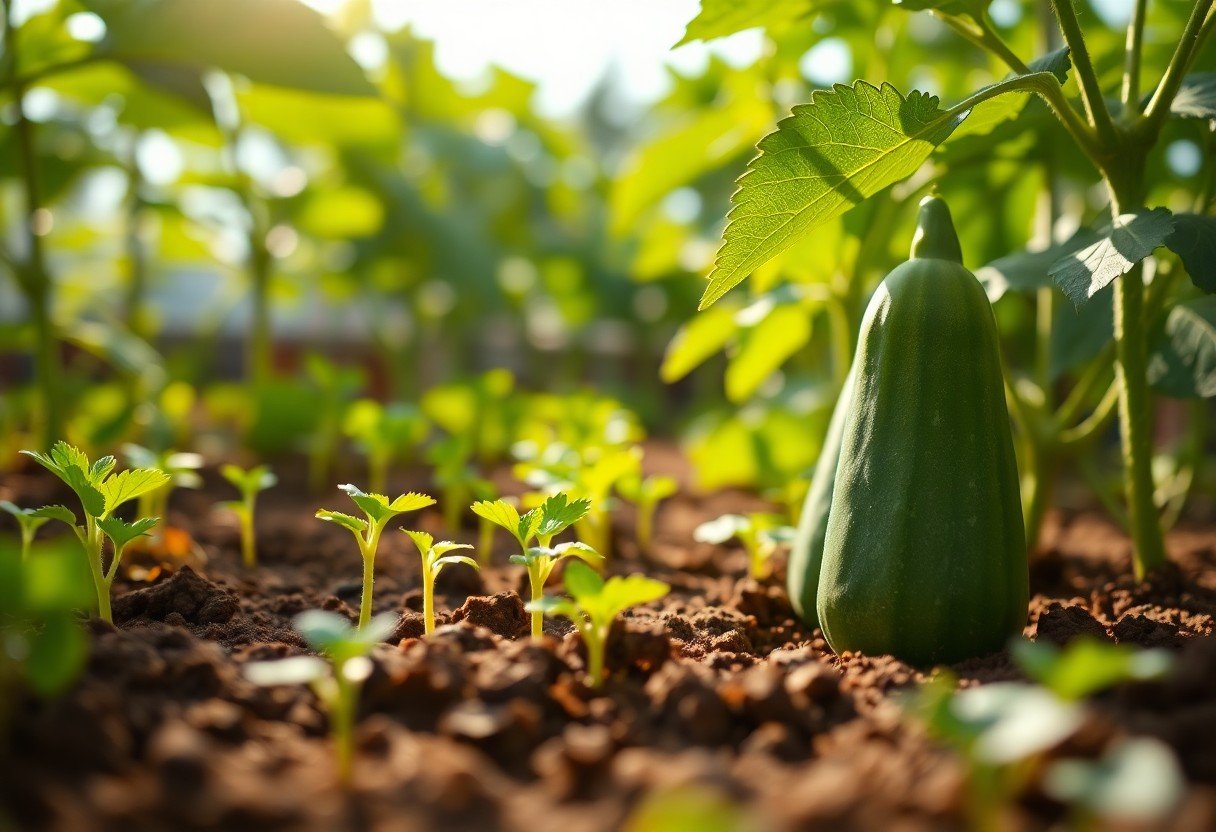
Care and Maintenance
Many aspiring gardeners can feel overwhelmed when it comes to the care and maintenance of their plants, especially cucumbers. However, with proper attention to watering and nutrition, you can provide your cucumbers with the perfect environment to flourish. Regular monitoring and adjustment of your care techniques will ensure robust growth and a bountiful harvest. Let’s break down the important components you need to focus on for your cucumber plants.
Watering Techniques
An effective watering strategy is pivotal for healthy cucumbers. These plants thrive in consistently moist soil, so it’s important to establish a routine that prevents both underwatering and overwatering. You should always check the soil moisture by sticking your finger about an inch into the ground; if it feels dry at that depth, it’s time to water. Generally, cucumbers benefit from a deep, thorough watering once or twice a week, depending on the weather conditions and soil type, to encourage strong root development.
Fertilization and Nutrient Needs
At the beginning of the growing season, providing your cucumbers with the right nutrients can vastly improve their yield and health. You should aim for a balanced fertilizer that contains equal parts nitrogen, phosphorus, and potassium, applied every few weeks after the plants have established themselves. As cucumbers are heavy feeders, particularly during their flowering and fruiting stages, keeping an eye on nutrient levels will directly impact your harvest outcome.
Considering the varying growth phases of cucumber plants, you may need to adjust your fertilization approach throughout the season. For instance, while a general-purpose fertilizer is suitable during the initial growth stages, you might switch to a fertilizer higher in phosphorus and potassium as the vines begin to flower. This adjustment supports blooming and fruit production, allowing you to reap the crunchy rewards of your gardening efforts.
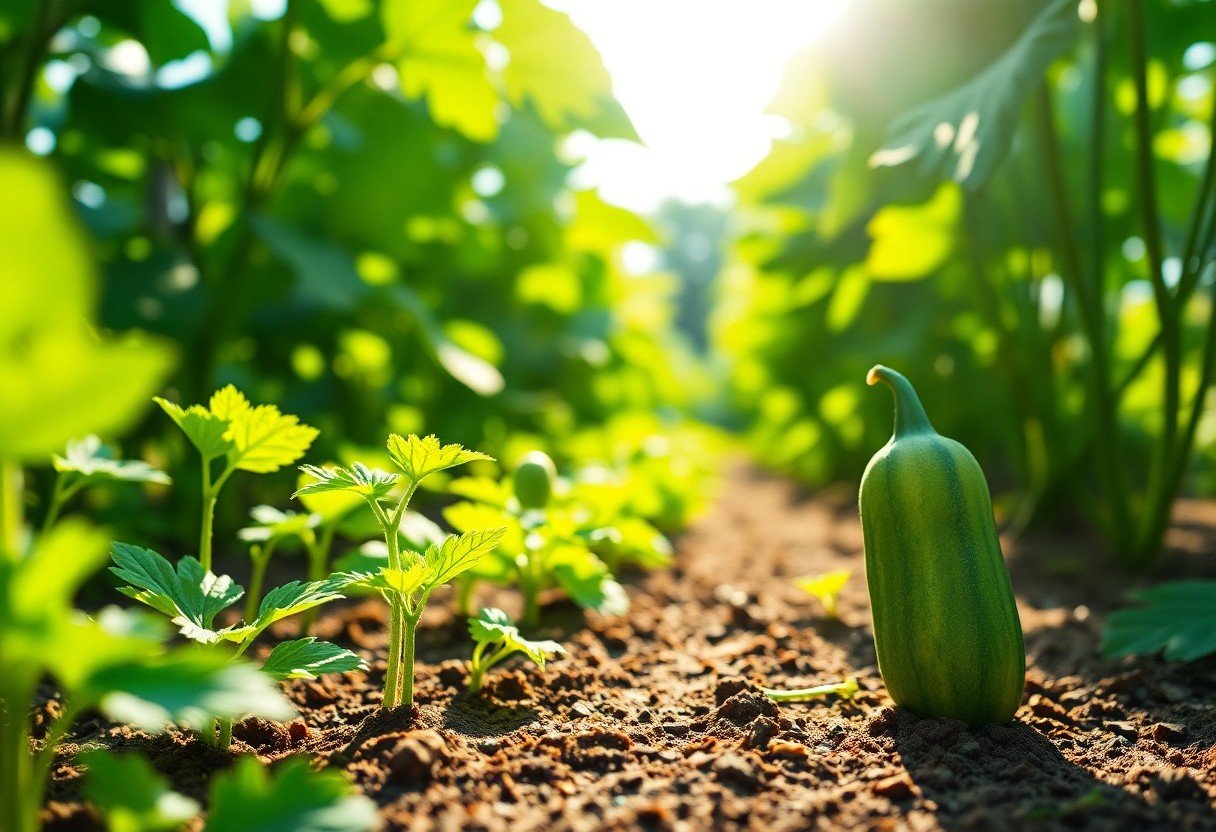
Pest and Disease Management
Now that your cucumbers are thriving, it’s time to focus on protecting them from pests and diseases that can threaten your harvest. Implementing a proactive pest and disease management plan can make all the difference in ensuring that you enjoy a bountiful crop. By understanding what lurks in the shadows and being prepared to deal with it, you can mitigate threats and maintain the health of your plants throughout the growing season.
Common Pests and Control Methods
Beside the joy of growing cucumbers, you must also be aware of common pests that can affect your plants. Aphids, cucumber beetles, and spider mites are a few examples that may invade your garden. To manage these unwanted visitors, consider introducing beneficial insects such as ladybugs and lacewings, which naturally prey on these pests. Additionally, using insecticidal soap or neem oil can effectively control infestations without harming helpful insects or your plants.
Recognizing and Addressing Diseases
Behind every healthy cucumber plant lies the potential for diseases that can compromise your crop. Fungal infections like powdery mildew or bacterial wilt can spell disaster if left unchecked. Keep an eye out for yellowing leaves, wilting, or unusual spots, all signs that something may be amiss. If you notice such symptoms, immediate action is necessary. Ensure proper air circulation by spacing your plants and removing any affected foliage, and consider applying appropriate fungicides to thwart the spread of infections.
Also, you can take preventive measures by rotating your crops each year and ensuring you use disease-resistant varieties of cucumbers when possible. A clean garden area, free from debris, will also reduce the chances of diseases taking hold. These small steps will help you create an environment that fosters healthy growth and deters diseases effectively. By remaining vigilant and proactive, you’ll cultivate a flourishing cucumber garden that stands strong against pests and diseases.
Harvesting Cucumbers
Keep in mind that timing is everything when it comes to harvesting cucumbers for their peak crunch. You want to ensure that you pick them at the right stage of maturity to enjoy the best flavor and texture. Typically, cucumbers are ready to be harvested when they have reached a size of about 6 to 8 inches long. This is when they are most tender and have the perfect amount of crispness. If you wait too long, they can become overripe, leading to a more bitter taste and tougher skin.
When to Harvest for Peak Crunch
Crunch is what you are aiming for, so keep an eye on the cucumbers in your garden. The best time to harvest is usually in the morning when the temperatures are cooler, and the moisture content in the cucumbers is at its highest. This ensures that you are picking them at their freshest. Additionally, look out for a vibrant green color and a smooth skin, which are indicators of optimal ripeness.
Best Practices for Harvesting
Harvesting cucumbers effectively not only aids in getting the best flavor but also promotes continued production. You should use a sharp knife or garden shears to cut the fruit from the vine, taking care to leave a small section of the stem attached. This minimizes damage to the plant and allows it to continue to grow and produce more cucumbers. Also, be sure to harvest your cucumbers regularly, which encourages the plant to yield more fruit.
And while you’re at it, it’s a good idea to handle your cucumbers gently, as their skin can be delicate. Place them in your basket or container carefully to avoid bruising. After harvesting, be sure to wash them quickly to remove any garden soil or pesticide residues, keeping them fresh until you’re ready to enjoy that delightful crunch in your next salad or snack. A little attention during the harvesting process can make a significant difference in the quality of your cucumbers on the plate.
Conclusion
Considering all points, you are now equipped with the fundamental knowledge to cultivate your own cucumbers successfully, from the initial seed selection to the delightful crunch of a homegrown harvest. By understanding the importance of soil quality, proper watering techniques, and pest management, you can create a thriving garden that yields fresh and crisp cucumbers. This journey not only enhances your gardening skills but also enriches your culinary experiences, allowing you to enjoy the freshest produce right from your backyard.
Your commitment to following these refreshingly easy steps will undoubtedly lead to fruitful results, making the gardening process enjoyable and rewarding. As you nurture your cucumber plants, you will gain a deeper appreciation for the fruits of your labor. So, embrace this adventure and take pride in the lush, vibrant greenery that will soon transform into delicious cucumbers, waiting to be savored in salads, pickles, or straight from the vine!








